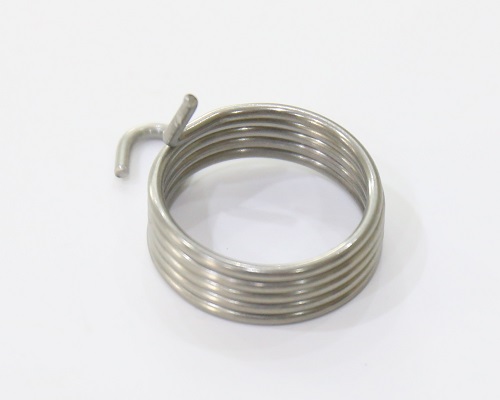扭簧
扭簧
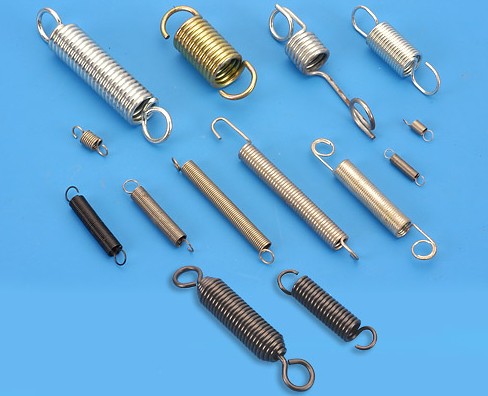
扭簧
產品說明:
1. 材質:各種金屬
2. 尺寸:各種尺寸
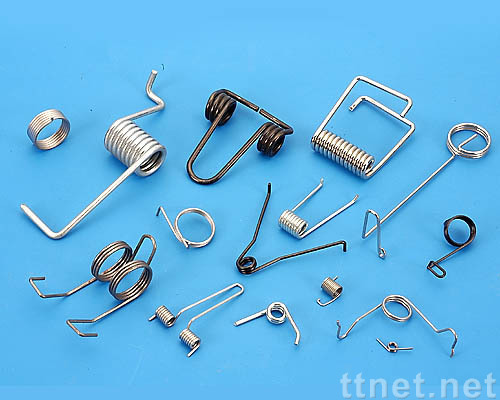 扭簧
扭簧
1. 材質:各種金屬
2. 不拘形態,複雜均能生產。
扭簧是一種螺旋狀的彈簧,其特點是當受到扭轉力時會提供回轉力矩,通常用於調節、控制或補償產品的轉動運動。
扭簧的形狀通常是圓柱形或圓錐形,並由彈性材料,例如不銹鋼、銅合金、鋁合金等製成。扭簧的特點是彈性變形,其彈性變形程度隨著扭簧受到扭轉力的大小而改變。
扭簧可以在各種不同的產品中使用,例如汽車懸掛系統、機械設備、電子設備、家具、手動工具等。在汽車懸掛系統中,扭簧通常用於控制車輛懸掛系統的彈性和硬度,以提高行駛穩定性和舒適度。在機械設備中,扭簧可以用於控制或調節裝置的轉動運動,以達到精確的控制效果。
扭簧的設計和製造需要考慮各種因素,如彈簧常數、扭簧比例極限、扭簧方向、材料選擇、熱處理、表面處理等。製造扭簧需要使用先進的技術和專業知識,以確保產品的質量和性能符合標準要求。
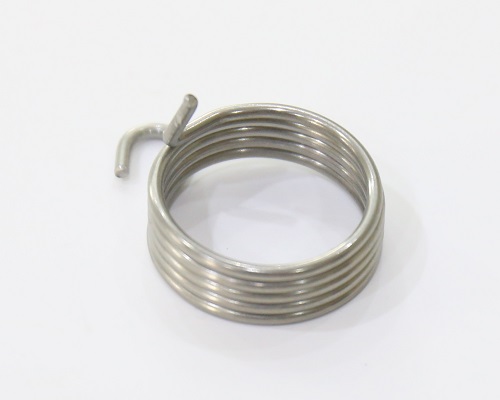 扭簧扭簧是一種彈簧的類型,它具有彎曲或旋轉的形狀,通常是圓柱形或圓錐形。扭簧通常用於承受轉動或扭轉力矩的應用中,並提供相應的彈性回彈力。
扭簧扭簧是一種彈簧的類型,它具有彎曲或旋轉的形狀,通常是圓柱形或圓錐形。扭簧通常用於承受轉動或扭轉力矩的應用中,並提供相應的彈性回彈力。
扭簧的主要功能是將應用施加在其上的轉動力矩轉換為彈性能量,並在力矩減小或消失時以回彈力將簧線恢復到其原始形狀。這使得扭簧在許多不同的應用中具有廣泛的用途,例如:
汽車:扭簧常見於汽車懸掛系統、車門、引擎門蓋和座椅調節器等部件中。它們能夠提供所需的扭轉力矩和回彈力,以實現穩定和可靠的功能。
家用電器:扭簧在家用電器中廣泛應用,例如冰箱門、洗衣機門、抽屜和門緩衝器等。它們能夠提供順暢的開啟和關閉操作,並確保組件的安全性。
工業機械:扭簧常用於各種工業機械中的扭轉機構和輸送設備。它們能夠提供所需的扭轉力矩和回彈力,以實現正確的操作和運行。
電子產品:扭簧也用於各種電子產品中,例如計時器、開關和按鈕等。它們能夠提供適當的扭轉力矩和回彈力,以實現精確的操作和觸感。
扭簧可以根據具體的應用需求和技術要求進行設計和製造。設計師需要考慮扭簧的材料選擇、線徑、彎曲方式、繞線方式以及彈性特性,以確保扭簧能夠提供所需的力矩和回彈力。扭簧的製造通常涉及線材的切割、彎曲和繞線等工藝步驟,並可能需要進行熱處理和表面處理等過程來改善其性能和耐久性。
如果需要扭簧,建議與專業的彈簧製造商或供應商合作,以確保獲得符合需求的高品質產品。他們可以根據您的具體需求提供定制的扭簧解決方案。
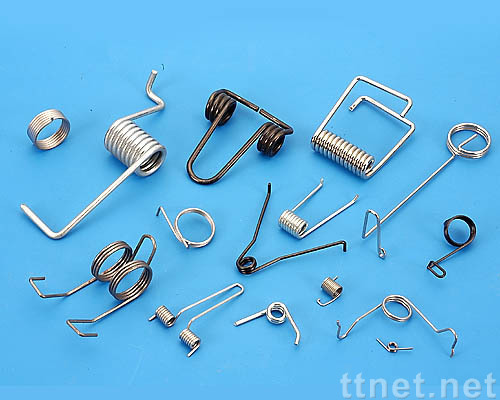 扭簧當談到扭簧時,以下是一些更多的相關信息:
扭簧當談到扭簧時,以下是一些更多的相關信息:
扭簧材料:扭簧可以使用多種材料進行製造,包括不鏽鋼、高碳鋼、合金鋼等。材料的選擇取決於應用的需求,如扭簧的負荷要求、耐腐蝕性、耐疲勞性等。
扭簧設計參數:扭簧的設計參數包括線徑、繞數、直徑、繞線方式和彎曲方式等。這些參數直接影響扭簧的彈性特性、力矩和回彈力。在設計過程中,需要根據具體應用需求和技術要求進行適當的選擇。
扭簧製造工藝:扭簧的製造通常涉及線材的切割、彎曲和繞線等工藝步驟。彈簧工廠使用現代化的製造設備和技術,如彈簧機、自動化生產線和熱處理設備,以確保生產高品質的扭簧產品。
扭簧特殊設計:在某些特殊應用中,可能需要進行特殊的扭簧設計。例如,錐形扭簧具有變截面,可以提供不同的扭矩和彈性特性。扭簧也可以進行雙向扭轉,以實現更複雜的運動要求。
扭簧的壽命和使用注意事項:扭簧的壽命取決於多個因素,包括負荷要求、工作環境、扭轉循環次數等。在使用扭簧時,應注意適當的安裝和使用,避免超過扭簧的設計負荷範圍,以延長其壽命並確保安全性。
扭簧在各個行業和應用中都有廣泛的應用。彈簧工廠和工程師將根據特定需求和技術要求進行扭簧的設計和製造。如果需要特定的扭簧解決方案,建議與彈簧專業人員合作,以獲得專業的建議和定制的產品。
扭簧的扭轉方向:扭簧可以根據需求進行不同的扭轉方向,如順時針或逆時針方向。這取決於應用中所需的力矩方向和旋轉要求。
扭簧的彈性特性:扭簧的彈性特性可以通過設計參數來控制,如線徑、繞數和繞線方式。這些參數將影響扭簧的剛度、彈性係數和回彈力。設計師需要根據應用需求和技術要求進行適當的調整。
扭簧的裝配和安裝:扭簧的裝配和安裝需要特殊的技術和設備。正確的裝配和安裝對於扭簧的性能和壽命非常重要。應遵循相應的裝配指南和安裝程序,以確保扭簧正確安裝並能夠正常工作。
扭簧的疲勞壽命:扭簧在長時間使用中可能會受到疲勞的影響,導致彈性特性減弱或失效。扭簧的疲勞壽命取決於設計、材料選擇和工作條件等因素。工程師可以使用疲勞分析和測試來評估扭簧的壽命。
客製化扭簧解決方案:彈簧製造商通常可以提供客製化的扭簧解決方案,根據客戶的特定需求進行設計和製造。這包括選擇適當的材料、設計參數、表面處理和包裝要求,以滿足特定應用的需求。
扭簧是一種常見且重要的彈簧類型,在各個行業和應用中發揮著關鍵作用。如果需要特定的扭簧解決方案,建議與彈簧製造商或供應商合作,以獲得專業的建議和定制的產品。
扭簧,也稱為扭力彈簧,是一種能夠承受扭轉應力的彈性元件。它們在各種機械設備中發揮著至關重要的作用,從工業機械、汽車、家用電器到電子產品,扭簧的應用範圍廣泛且不可或缺。本文將深入探討扭簧的基本原理、種類、製造工藝、應用範圍以及未來發展方向。
扭簧的基本原理
扭簧的工作原理基於扭轉應力,即當彈簧受外力作用時,會發生扭轉變形並儲存能量,當外力解除後,扭簧會恢復原狀,釋放儲存的能量。扭簧的變形和恢復過程符合胡克定律,即在彈性極限內,變形量與施加的力成正比。
扭簧的種類
根據用途和設計,扭簧可以分為多種類型:
單扭簧:僅有一個扭轉方向的彈簧,應用於需要單方向扭轉力的裝置中。
雙扭簧:具有兩個相反扭轉方向的彈簧,提供雙向扭轉力,常用於復雜的機械系統中。
平衡扭簧:設計用於保持系統平衡,應用於需要精確控制的場景,如電子儀器和精密機械。
異形扭簧:根據特定需求設計的特殊形狀扭簧,用於滿足特定應用的需求。
扭簧的材料選擇
製作扭簧的材料主要包括高碳鋼、不銹鋼、合金鋼以及鎳合金等。這些材料具有高彈性、高強度和耐疲勞等優點,能夠在多次使用中保持穩定的性能。隨著材料科學的不斷發展,更多具有優異性能的新材料也被逐步應用於扭簧的製造中。
扭簧的製造工藝
扭簧的製造是一個複雜的過程,涉及多道工序和精密的控制。以下是扭簧生產的主要步驟:
原材料準備
扭簧的生產始於高品質原材料的選擇和預處理。根據扭簧的用途和要求,選擇合適的材料並進行清洗和去除雜質,以確保材料的純淨度和穩定性。
成形加工
成形是扭簧生產的關鍵步驟。根據扭簧的形狀和尺寸,成形方法包括冷加工和熱加工。冷加工主要用於製作小型和中型扭簧,而大型扭簧則通常採用熱加工工藝。
熱處理
熱處理是提升扭簧性能的重要工序。通過淬火、回火和退火等熱處理方法,可以改善扭簧的內部結構和力學性能,使其具有更高的硬度、彈性和抗疲勞性能。
表面處理
為了提高扭簧的抗腐蝕性能和美觀度,需要進行表面處理。常見的表面處理方法包括電鍍、噴漆和氧化等。這些處理不僅能夠延長扭簧的使用壽命,還可以提高其在惡劣環境下的穩定性。
質量檢測
每一個出廠的扭簧都需要經過嚴格的質量檢測。質量控制部門會對扭簧的尺寸、彈性和耐久性進行全面檢測,確保其符合設計要求和行業標準。
扭簧的應用範圍
扭簧在各類機械設備和日常用品中有著廣泛的應用,以下是幾個主要應用領域:
工業機械
在工業機械中,扭簧的應用非常廣泛。比如,各類機床、壓力機和自動化設備中,扭簧負責提供穩定的扭轉力和恢復力,保證機械裝置的正常運轉和精確控制。
汽車工業
在汽車工業中,扭簧廣泛應用於各類汽車零部件中,如離合器、剎車系統和車門鉸鏈等。扭簧的存在確保了汽車的安全性和穩定性,提升了駕駛的舒適性和便捷性。
消費電子
在消費電子產品中,扭簧也發揮著重要作用。比如,各類按鍵和連接部件中的扭簧,提供了穩定的彈力和連接效果,確保產品的正常使用和耐久性。
醫療設備
在醫療設備中,扭簧同樣不可或缺。各類手術器械和醫療裝置中的扭簧,確保了操作的精確性和穩定性,提升了醫療設備的性能和可靠性。
日常生活用品
在日常生活中,我們經常能夠看到扭簧的身影。比如,彈簧夾、夾子和各類運動器材中,扭簧提供了舒適的彈性和支持,提升了使用體驗和舒適性。
扭簧的技術創新
隨著科技的不斷進步,扭簧的技術創新也在不斷推進。以下是幾個重要的技術創新方向:
自動化生產
自動化生產是現代扭簧製造的一大趨勢。自動化設備的引入,不僅提高了生產效率,還降低了人工成本和生產過程中的誤差。自動化成形機、數控機床和機器人技術的應用,使得扭簧生產變得更加精確和高效。
智能製造
智能製造是工業4.0時代的重要特徵。扭簧製造通過引入物聯網、人工智能和大數據技術,實現生產過程的智能化管理。這些技術可以實時監控生產狀態、預測設備故障和優化生產流程,從而提高生產效率和產品質量。
新材料的應用
新材料的開發和應用,是提升扭簧性能的重要途徑。比如,使用鎳鈦合金和複合材料,使得扭簧在重量、強度和耐腐蝕性方面有了顯著提升。這些新材料的應用,特別適用於高性能工業設備和惡劣環境下的應用。
綠色製造
環保和可持續發展是未來工業發展的重要方向。扭簧製造通過採用綠色製造技術,降低生產過程中的能耗和污染。比如,無鉛電鍍技術和節能型熱處理設備的應用,不僅減少了環境污染,還降低了生產成本。
扭簧技術的未來展望
隨著科技的不斷進步,扭簧技術的未來發展充滿了無限可能。以下是幾個重要的發展方向:
新型材料的研發
未來,隨著材料科學的進步,更多具有優異性能的新材料將被應用於扭簧的製造中。這些新材料將進一步提升扭簧的性能,滿足更加苛刻的應用需求。
更高精度的製造技術
隨著生產技術的進步,扭簧的製造精度將進一步提高。新型數控機床和先進的加工工藝,將使得扭簧的尺寸精度和性能穩定性達到新的高度。
智能化和數字化
智能化和數字化將成為未來扭簧製造的重要方向。通過引入人工智能和大數據分析,實現生產過程的全面自動化和智能化管理,將顯著提升生產效率和產品質量。
可持續發展
未來的扭簧製造將更加注重環保和可持續發展。通過採用綠色製造技術和可再生能源,減少生產過程中的能耗和污染,實現環保與經濟效益的雙贏。
結論
扭簧作為機械設備和日常用品中的重要元件,對確保設備的穩定性和可靠性起著關鍵作用。隨著科技的不斷進步,扭簧的製造技術和應用範圍也在不斷擴展。未來,隨著智能製造、綠色製造和新材料技術的發展,扭簧將迎來更加廣闊的發展空間,為現代工業和人類生活帶來更多的便利和可能。
